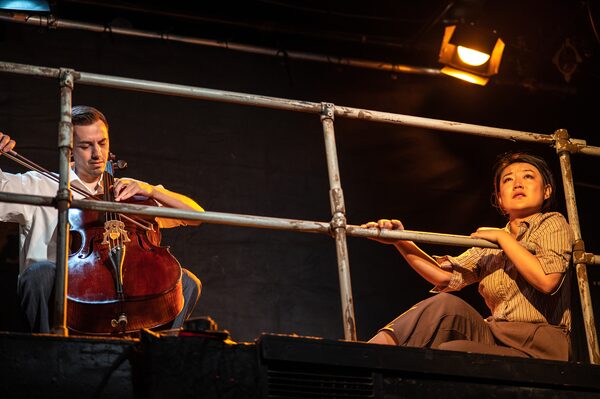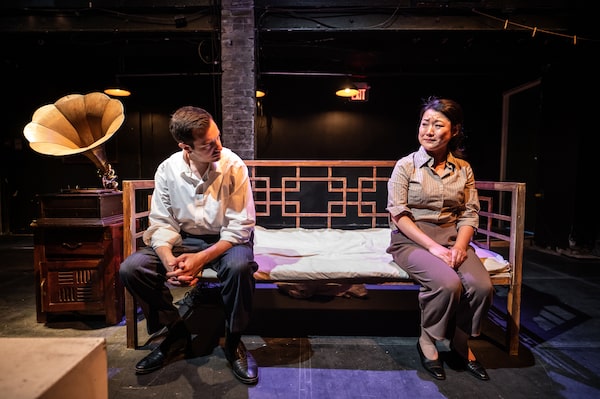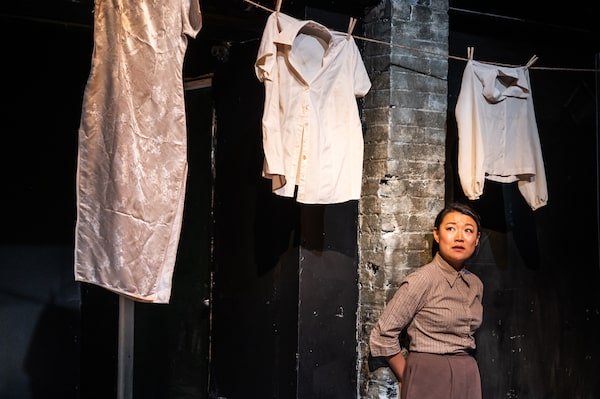
Bryan Holt, left, and Rong Fu in The Year of the Cello.Dahlia Katz/Theatre Passe Muraille
- Title: The Year of the Cello
- Co-created by: Marjorie Chan and Njo Kong Kie
- Director: Marjorie Chan
- Actors: Rong Fu
- Company: Theatre Passe Muraille and Music Picnic
- Venue: Theatre Passe Muraille’s Bob Nasmith Innovation Backspace
- City: Toronto
- Year: To Oct. 29
The Year of the Cello marks the official return of live, in-person performance to Toronto’s Theatre Passe Muraille. It’s also a show that might be better experienced at home – and soon, in fact, will be available for consumption on the couch.
This short duet for actor and cellist, just 60 minutes long, is the co-creation of the writer and director Marjorie Chan and the composer Njo Kong Kie. They are also the artistic directors of the show’s co-producers, Theatre Passe Muraille and Music Picnic, respectively.
Wen (Rong Fu), the narrator of the play, delivers a monologue soaked in and stunted by grief.
It’s the 1930s in Hong Kong – and she is telling us about a beloved friend named Li-Ann who is now gone. She seems to place the blame for her death on an unnamed cellist. (Bryan Holt played that cellist, who only speaks through their instrument, on the night I was there; Brendan Rogers plays the role on alternating nights).
Is The Year of the Cello about a love triangle? Not quite.

Holt plays a cellist and Fu plays the friend of a victim, who places the blame on the cellist.Dahlia Katz/Theatre Passe Muraille
Wen begins by recounting the difficult childhood she and Li-Ann went through together, marked by a final wave of the bubonic plague that hit Hong Kong in 1929.
The cellist appears to Wen and Li-Ann on a ferry ride taken many years after those traumatic events – and the question at the heart of the show seems to be whether music is only a healer, or if it can also reopen wounds and hurt anew.
In the course of the production, the cellist plays one of Bach’s cello suites and some new music written for this show; the musical highlight is the final composition by Kong Kie in which the cello, in some ways a stand in for the absent Li-Ann, is explored from top to bottom.
Hong Kong has been described, earlier, by Wen as a site of many contradictions – of both East and West, ancient and new. She calls it a place that is crowded and yet isolating, one that is freer now than it used to be in some ways, but less free in others.
Kong Kie’s composition dramatizes all those tensions in that last composition, the harmony and dissonances of differences sparring with each. It’s Hong Kong in one song – and an engrossing monologue without words to end a play that makes it clear that, much as we might want to move on, a pandemic always has long-term repercussions.
The Theatre Passe Muraille Backspace, where The Year of the Cello is being staged, has been the birthplace of many notable shows over the decades: Judith Thompson’s The Crackwalker, Linda Griffith’s Maggie and Pierre and Anusree Roy’s Pyaasa to name just a few.
It’s now been renovated and officially rechristened the Bob Nasmith Innovation Backspace, after the late actor and board member, a beloved character on and off the stage who, most recently, starred in a haunting production of Krapp’s Last Tape in the space.

Fu is the narrator of The Year of the Cello.Dahlia Katz/Theatre Passe Muraille
The Backspace still looks a little rough around the edges, as Nasmith usually did, but it is more versatile now.
The Year of the Cello demonstrates a newly available configuration in which the space (a former stable) is turned into one big rectangular stage. Two rows of seats have been placed up against one wall, allowing for a wide staging area and a second level to be used as a kind of balcony.
Unfortunately, Chan’s stodgy staging and a lacklustre design doesn’t really make much of a case for this set-up. Indeed, though opened up, the theatre felt more cramped than usual. When the performers were up high, I felt I was craning my neck to look at them; on the lower level, meanwhile, an imposing bed was positioned by production designer Echo Zhou much too close to the audience and took up too much stage space (though it was barely used by the performers).
Coming out of the pandemic, Theatre Passe Muraille continues to prioritize accessibility in its art making. The Year of the Cello is not just having relaxed performances, but a fully relaxed run – which in this case means low-level light at all times and an invitation to enter and exit as needed. Chan also worked with consultants to make this show a blind-friendly production – which led to costuming and bits of staging being described in the dialogue. The seeing among the audience were invited to close our eyes if we wanted to and just listen.
The Year of the Cello will be later be available as a digital audio-only version created with binaural sound technology, providing a 360-degree listening experience. It’s hard to come up with a strong argument for going in-person instead.